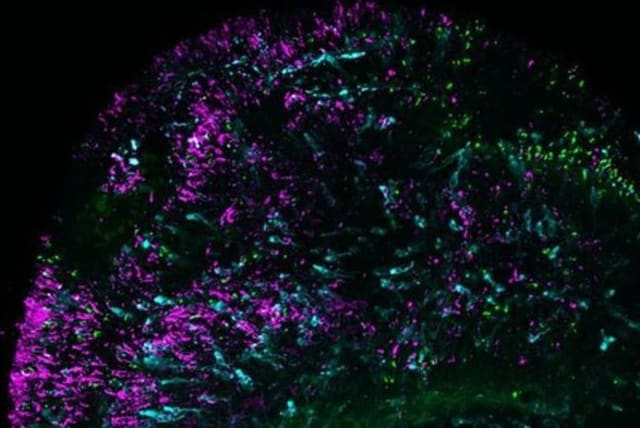Lab-grown retinas explain why people see millions of colors but other mammals can’t

With human retinas grown in a petri dish, researchers discovered how an offshoot of vitamin A generates the specialized cells that enable people to see millions of colors.
Many animals have advantages over humans: Dogs and cats have a more acute ability to smell; cows can subsist on grass and hay; and giraffes can reach high into the trees for food. But mammals can’t see the millions of colors that people can.
With human retinas grown in a petri dish, researchers discovered how an offshoot of vitamin A generates the specialized cells that enable people to see millions of colors, an ability that dogs, cats, and other mammals do not possess.
Because dogs’ eyes have only two types of cones (just 20% of the cones in human eyes), their color spectrum is limited to shades of gray, brown, yellow, and blue. This is called dichromatic vision, which is similar to humans who experience red-green color blindness.
Cats can see colors, but they don't see quite as many different shades as humans can. Due to the construction of their eyes, the colors that cats can see best are blue and yellow, while red and green appear to them as shades of grey, similar to people who are red-green color blind.
“These retinal organoids allowed us for the first time to study this very human-specific trait,” said author and biology Prof. Robert Johnston at Johns Hopkins University in Baltimore. “It’s a huge question about what makes us human, what makes us different.”
The findings, just published in the journal PLOS Biology under the title “Retinoic acid signaling regulates spatiotemporal specification of human green and red cones,” increase understanding of color blindness, age-related vision loss, and other diseases linked to photoreceptor cells. They also explain how genes instruct the human retina to make specific color-sensing cells, a process that scientists thought was controlled by thyroid hormones.Cones are a type of photoreceptor cell in the retina of the eye that give us our color vision. They are concentrated in the center of the retina, which has about 120 million rods and six million cones in an area called the macula and help us see fine details. Rods are a type of photoreceptor cell in the retina that are sensitive to light levels and help give us good vision in low light. Concentrated in the outer areas of the retina, they give us peripheral vision. Rods are 500 to 1,000 times more sensitive to light than cones.
By tweaking the cellular properties of the organoids, the research team found that a molecule called retinoic acid determines whether a cone will specialize in sensing red or green light. Only humans with normal vision and closely related primates develop the red sensor.
Scientists have thought for decades that red cones formed through a coin-toss mechanism in which the cells haphazardly commit to sensing green or red wavelengths. Research from Johnston’s team recently hinted that the process could be controlled by thyroid levels. Instead, the new research suggests red cones materialize through a specific sequence of events orchestrated by retinoic acid within the eye.
The team found that high levels of retinoic acid in early development of the organoids correlated with higher ratios of green cones. Similarly, low levels of the acid changed the retina’s genetic instructions and generated red cones later in development.
“There still might be some randomness to it, but our big finding is that you make retinoic acid early in development,” Johnston said. “This timing really matters for learning and understanding how these cone cells are made.”
Green and red cone cells are remarkably similar except for a protein called opsin that detects light and tells the brain what colors people see. Different opsins determine whether a cone will become a green or a red sensor, though the genes of each sensor remain 96% identical. With a breakthrough technique that spotted those subtle genetic differences in the organoids, the team tracked cone ratio changes over 200 days.
“Because we can control in organoids the population of green and red cells, we can kind of push the pool to be more green or more red,” said author Sarah Hadyniak, who conducted the research as a doctoral student in Johnston’s lab and is now at Duke University in North Carolina. “That has implications for figuring out exactly how retinoic acid is acting on genes.”
The researchers also mapped the widely varying ratios of these cells in the retinas of 700 adults. Seeing how the green and red cone proportions changed in humans was one of the most surprising findings of the new research, Hadyniak said.
Scientists still don’t fully understand how the ratio of green and red cones can vary so greatly without affecting someone’s vision. If these types of cells determined the length of a human arm, the different ratios would produce “amazingly different” arm lengths, Johnston said. “The future hope is to help people with these vision problems,” Johnston said. “It's going to be a little while before that happens, but just knowing that we can make these different cell types is very, very promising.”
Jerusalem Post Store
`; document.getElementById("linkPremium").innerHTML = cont; var divWithLink = document.getElementById("premium-link"); if (divWithLink !== null && divWithLink !== 'undefined') { divWithLink.style.border = "solid 1px #cb0f3e"; divWithLink.style.textAlign = "center"; divWithLink.style.marginBottom = "15px"; divWithLink.style.marginTop = "15px"; divWithLink.style.width = "100%"; divWithLink.style.backgroundColor = "#122952"; divWithLink.style.color = "#ffffff"; divWithLink.style.lineHeight = "1.5"; } } (function (v, i) { });
